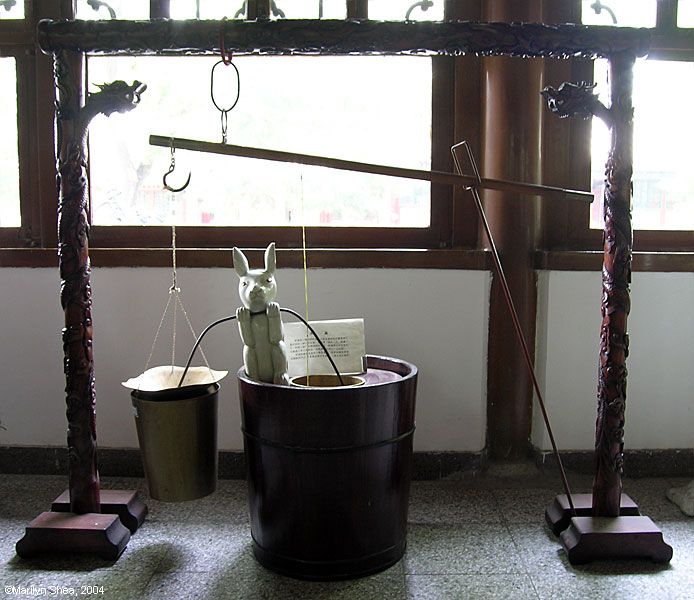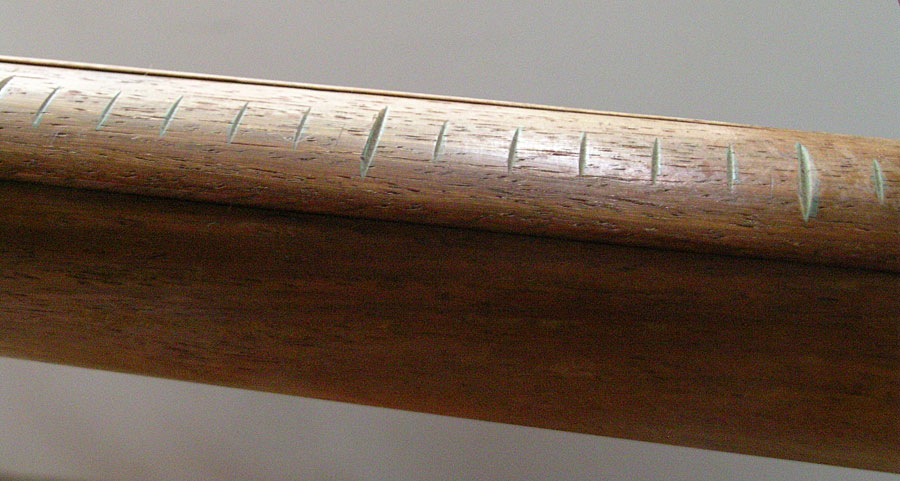 |
| The steelyard clepsydra (秤漏 chènglòu) is a type of water clock invented in the Northern Wei Dynasty (386-584) by a Daoist monk named Lǐ Lán (李兰). Water is siphoned from one bucket to the other and as the weight changes in the brass bucket the steelyard changes position. The beam is marked as shown below with ridges and the guide clicks into the ridges telling the time. There should be a counter-weight or plumb hanging from the right side of the steelyard, but it seems to be missing. The steelyard clepsydra was so accurate that it replaced other forms of clepsydra (漏刻 lòukè) and was used into the Northern Song Dynasty (960-1127). |
 |
| Up to the Eastern Han Dynasty, clepsydras were marked in gradations of 100 parts to an hour. At that time, clepsydras were primarily of the leaky bucket type, where one bucket had a pinhole in it and leaked into a second which had a floating marker which would rise and the time could be told off the gradations. There were 12 hours in a day. During the reign of Emperor Aidi, a Daoist convinced the emperor to change to 120 parts to the hour. Daoists were strongly involved in astronomy through history because they were astrologers.
For Daoists, there is a correspondence between heaven and earth. The constellations have spirits that influence events on earth. Praying to the Big Dipper or Plough is believed to change the course of events on earth and in the personal lives of the people. The Daoist calendar was based on the 28 constellations. Each constellation had its own powers. It began with the Kui constellation and at midpoint the Jiao constellation. Twelve equal months of 30 days had to be fit into the calendar. The problem with that was the year would then only be 360 days. The calendars quickly went off-cycle with the constellations. Astrology and the need for symmetry drove the form of the calendar, but also drove the Daoists to develop new and better techniques to observe the stars and to keep time. They both contributed to the advance of astronomy and influenced its course through the dynasties. Daoist beliefs supported the astrological principle that the Emperor bore a Mandate from Heaven. It was not a part of Buddhist teaching. The obsession of the throne with time and time keeping came from a desire to be in harmony with the heavens and the belief that the emperor was indeed chosen by the gods to be one with them and to rule on earth. Those beliefs arose out of the pre-dynastic belief systems but were fully supported and incorporated into Daoism. Confucius wrote about ritual and the need for proper observation of ritual to maintain good government, but that was a reflection of the belief system that supported elaborate ritual to affect change in or to appease the heavens. Performing the rites of Spring on the correct day at the correct hour and in the correct manner as defined by the position of the stars and the moon would determine whether your dynasty would last and your personal good fortune would continue. Calendar creation served religious, philosophical, and political purposes well beyond the need to predict the correct day to plant the wheat. Evenness and balance were imposed on the calendar and when it was no longer accurate it was reset. The external principles and concepts had more reality than did the actual days. There ought to be 30 days in a month, so the system must incorporate that idea in some form. It was much easier to change the calendar in China than in the West because it was seen as a predictive system rather than a real part of time. This view of time is strange for a western culture that had a calendar revision in 45 BC, the Julian calendar, and then again in 1582, the Gregorian calendar, both of which were based on dividing the solar year by the number of days. The resistance shown to calendar change in the West is indicative of a different view of the relationship between time and the calendar. Aside from the fact that the solar calendar does not need to be reset as often, there are certainly methods that could remove some of the quirkiness that was built in through history. The use of the calendar by many different political systems across Europe also played (plays) a major role in stability. It is much easier to get a single Emperor to agree than to get ten Kings to agree to a change. Religious needs also differ between the cultures. In Chinese culture the need for an exact celestial definition of the start of Spring Festival contrasts to a pragmatic Christian culture that placed the celebration of the birth of Christ arbitrarily to coincide and compete with the pagan holiday of Saturnalia. For the Christians, the position of objects in the sky had little to do with their beliefs or with their ability to supplicate their God. |
http://hua.umf.maine.edu/China/beijing2.html
Last
update: May 2007
© Marilyn Shea, 2007